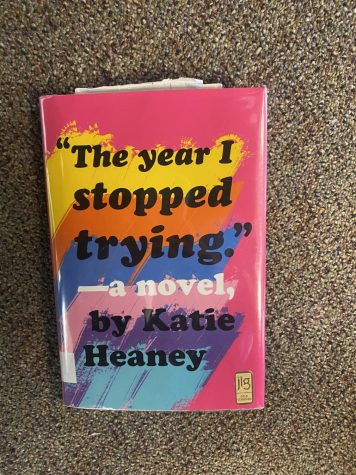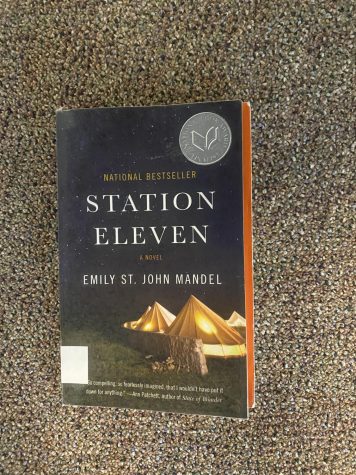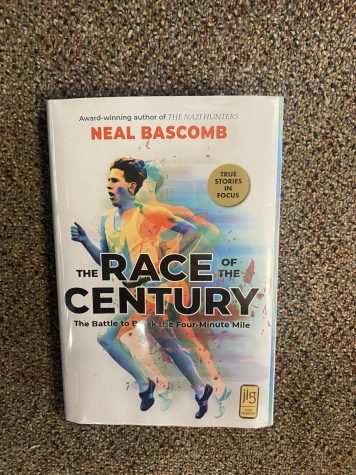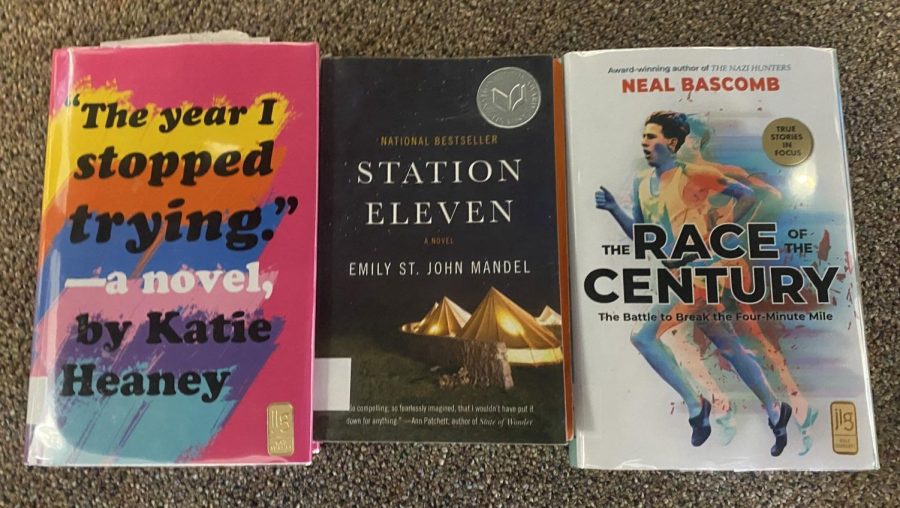Book review: three recent additions to Amador’s library
All three of these books are different genres, providing three distinct but interesting reads.
This month, to celebrate Spring and the end of the school year, the library has put out a table of newly arrived books for students. The books encompass a wide variety of genres from mysteries, contemporaries, to high fantasy. In order to relieve stress before finals and work towards my Goodreads goal, I decided to check out three of these books for myself. I checked out “The Year I Stopped Trying “ by Katie Heaney, “Station Eleven” by Emily St. John Mandel, and “The Race of the Century” by Neal Bascomb.
“The Year I Stopped Trying” by Katie Heaney (2021)
This book follows Mary, a girl who thrives on academic validation, and her downward spiral as she decides to stop trying in school in order to find her true self. Her one mission; to find a “bad boy” boyfriend and in the process convince people she is cool.

“The Year I Stopped Trying” was a hilarious book that made me laugh out loud more times than I can count. The humor and wit in this book is brilliant, making Mary relatable to a teenage audience as she encounters everything from first love, jealousy, identity issues, to mundane things like her boring job at La Baguette and classes. A running joke throughout the book that is painfully relatable to those in the foodservice industry are the ridiculous customers Mary encountered, from the yoga lady who got angry at the lack of back bean soup to the stoned teenagers who don’t know how to order.
However, for all its hilarity, Mary’s journey throughout the book introduces deeper topics and themes that resonate with a younger audience. For all her jokes, Heaney undercuts many with a dark undertone, revealing throughout the book Mary’s trouble with religion, what she wants out of life, and questions about her sexuality.
Mary’s guidance counselor, while a minor role, is one of the best characters because she actually pays attention to what Mary wanted and spoke to her like an adult, helping Mary to articulate her true feelings in the end, the goal of her whole so-called “self deterioration project.”
One thing that is a little lacking in the book is the development of some of the characters and relationships, as some of the characters seem like mere props for Mary and her problems. In particular, AJ and her group of friends are painted out to be the stereotypical popular mean kids. With little evidence to back up this characterization. it seems forced and cliche, there for the sole purpose for Mary to criticize. In the same sense, Justin, assistant manager at La Baguette, is a stereotypical mean boss that thrives on reprimanding teenagers. While funny at times, his actions are never explained, and he never has any depth to his character, which I would have wanted to see.
“Station Eleven” by Emily St John Mandel (2014)
This book is set in a post pandemic world, after civilization has collapsed. It follows the ensemble cast of the Traveling Symphony as they traverse the desolate landscape in order to put on performances of Shakespeare to the survivors with flashbacks to life before the pandemic with King Lear star, Arthur Leander. Station Eleven was a surprisingly interesting read. I was apprehensive to pick it up due to the current COVID-19 pandemic, but ended up enjoying the narrative that unfolded.

Mandel’s structure and style of writing is excellent in this novel, bringing together three different storylines, Jeevan’s, Arthur and his relationship’s, and Kirsten’s, in a unique way. The jump between the pre-pandemic and the present day storylines is well balanced, as the present day storylines leave many things up in the air, such as the origin of the graphic novel “Station Eleven,” and where the villainous prophet came from.
No storyline ever feels particularly boring, as the present day storyline promises mystery and high stakes survival, while the pre pandemic stories delve into nuanced characterization, and scattered clues throughout that link everything together. The way everything ties together is satisfying to read, and symbolic of the multifaceted story Mandel came up with. The more I read about Arthur from before, the less heroic he becomes and the more that Miranda, a victim of Arthur’s infidelity, turns into one of my favorite characters.
There were many emotional moments in the book that hit me harder than I would expect. Miranda’s fate at the start of the pandemic, while expected, made me tear up a little as her practical, ambitious nature could not fare against the unpredictability of the virus, making her helpless.
On the other hand, there are many heartwarming moments in the post pandemic world between the Traveling Symphony that juxtaposes the bleak nature of the world, making the book more than a depressing dystopian novel. The dynamic between Kirsten and August is wholesome and purely platonic, particularly the scene where they raid houses together, each of them knowing each other’s habits in these expenditures. The conversations between the theater troupe are entertaining as well, as they act like a dysfunctional but loving family, showing the theme that one might take refuge in a chosen family.
“The Race of the Century” By Neal Bascomb (2022)
This story follows Wes Santee, an American from Kansas, John Landy, an Australian, and Roger Bannister, a med student from Britain, and their race to become the first person to run a sub 4:00 minute mile in the 1950’s. This book was the first nonfiction book I have picked up in a while, and while not my usual genre, it ended up being a touching, emotional, and riveting story about running and beating world records.

As a runner myself, I was intrigued by the emphasis on running, excited to read a story about the best of the best, everything from how they trained to what they ate before races. It was enlightening to see each of the three athletes’ contrasting training and race techniques, from Roger Bannister who uses pacers and runs a conservative race compared to John Landy, who always stays at the front of the pack. It really brought home the message that every runner is unique and goes about their goals differently.
What I could not expect was how much I got attached to the characters. Wes Santee, with his cowboy boots and determination even in the face of struggle, is the most interesting character to learn about, on and off the track. The mentorship under his coach Bill Easton is more of a father-son relationship than his cold biological dad ever was, with Easton and Santee having squabbles over Santee’s commitment to the team, but Easton nonetheless having a soft spot for Santee. The best moment between the two is when it rains right before Santee’s race at the Kansas Relays, and Bill Easton immediately starts commanding all of the people on the team to clean up the track, so Wes’s dream is not ruined.
Speaking of weather and other obstacles, an intriguing aspect of this book is how many times these three athletes fail, with things in and out of their control hindering their dreams constantly. It made the story actually interesting, showing them at their very best and very worst. No one is perfect; everyone has bad races. This was also relatable to me as a runner, as when the characters did not get the time they wanted, they crossed the finish line and saw their time with disappointment. The writing invoked a hollow feeling in me as I can understand the pain associated with a bad race. All in all, this gives the book grit and tension, making me alternate between relating to that athlete’s sadness, rooting for them in spite of the odds, and biting my fingernails in suspense.
The best chapter of the book undoubtedly had to be the last chapter. With Bascomb’s descriptive language and understanding of the technicalities and strategies of racing the mile, I felt like I was in the stands at the 1954 Empire Games, on the edge of my seat, unsure whether Bannister or Landy would win the race. With each exhausted thought that passes through the two athletes’ heads, on when they would make their pass, concerns about their rivals position, it turns one race into a final battle of sorts, not dissimilar to the climactic battle in a fantasy novel.
Verdict
The three books that I picked up this month were entertaining to read and a good distraction from the end of year stress. While these books had not been on my to be read list before, their colorful covers and creative titles drew me in, giving it the sense of three separate blind dates with each book. I went in with no expectations and came out pleasantly surprised.
Your donation will support the student journalists in the AVJournalism program. Your contribution will allow us to purchase equipment and cover our annual website hosting costs.

